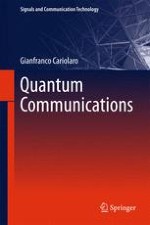2015 | OriginalPaper | Chapter
12. Classical and Quantum Information Theory
Author : Gianfranco Cariolaro
Published in: Quantum Communications
Publisher: Springer International Publishing
Activate our intelligent search to find suitable subject content or patents.
Select sections of text to find matching patents with Artificial Intelligence. powered by
Select sections of text to find additional relevant content using AI-assisted search. powered by
